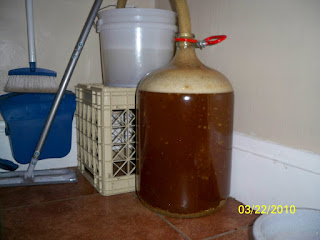For me its brewing season!!!
Brew day is my time to relax, listen to some music, have some beers and just enjoy the day. During the spring I would brew a batch of beer every other weekend so that i could have a nice little supply for the summer. The summer is just way to busy for me to spend a day brewing, not that i don't want to but i just never seem to find the time. Fall though is a different story, sure there are still lots of things going on but i seem to always find time to brew. Besides, I am down to just a keg of Bourbon Porter and a Harvest Ale that really doesn't taste as good as i hoped.
This fall i am really trying to build up a nice supply of my IPA by brewing a 5 gallon batch every weekend. This way i should have enough to last me through the winter. So far i have 10 gallons and am planning on another 5 this weekend.
How do i brew beer? Well I'm glad you asked, the first step is to figure out what ingredients I'm going to use. For my IPA the recipe is:
10 lbs Maris Otter Malt
4 lbs Weyermann Floor-Malted Bohemian Pilsner Malt
3 oz Cascade Hops
.5 oz Summit Hops
Safale US-05 Yeast
Then you must crack the grain, but not grind it into a flour, and remove the husk. Here is the small grain mill I use and the cracked grains.
Now the cracked grain must be mashed for about an hour in around 150 degree water. This is how you extract the sugars from the grain. I use a cooler with a copper manifold at the bottom as my Mash Tun.
Now its time for the Sparge! Sparging is the process of rinsing the grain with water in order to leech out all the sugars left in the grain. This is done by slowly raining water (170 degrees F) over the grains, allowing the water to flow through the grain and out the bottom of your container into your brew kettle. First you have to run the the liquid, which is now called wort, thru the grains so allow the grains and the husks to form a filer bed. then when the wort has cleared up, or is not cloudy anymore, then you can start to sparge. I use an old beer cooler to hold the 170 degree water, it actually holds the temp quite well and let the water slowly run into a colander. For the IPA I add 1 oz of cascade hops to the colander to mix with the sparge water. This adds a nice bitterness to the beer.
This process usually takes about 2 hours, the slower the sparge water filters thru the grain bed the better. I have it set up so that i can just set the sparge water and the wort going to the brew kettle to flow at the same rate. This way i can just leave it and do other things while the kettle is filling. Once its filled it is time to start boiling.
Im may take awhile to start boiling, but once it does you have to watch out, it will boil over. Especially when you add the hops! For this recipe i add 1.5oz of Cascade hops at the beginning of the boil, another .5 oz at 30 mins, and .5 oz of Summit with 10 mins left. The boil takes an hour and hop additions are timed by time left till boil is done, or flame out. Then you have to chill the hot wort as fast as possible. I use 30 feet of copper tubing that i coiled up and run cold water thru, i'll have to take a pic next time i brew. This will chill the wort to 65 degrees in about 10 mins. The reason you must chill the wort is so that the yeast can survive. Pitching the yeast into 65 degree wort will give it the best chance to start multiplying and eating up the sugar as soon as possible. The reason it must be done fast, is because bacteria also want to feed on these sugars, wait too long and the bacteria will take hold and cause off flavors in your beer. Now your wort is ready to ferment.
I funnel the chilled wort into a 6 gallon glass carboy and add the yeast. Then attach a blowoff tube to the top of the carboy and place the other end in sanitized water. A blowoff tube is necessary as a normal airlock will be forced off the top, the beginning of fermentation is quite explosive. This process will take about a week and then its time to siphon off the beer and put it in a secondary fermenter to clear up.
Depending on the beer, you should keep it in the secondary for 2 to 4 weeks so the beer has time to clear up. You will see a thin line of sediment at the bottom. Now its time to keg the beer, force some carbonation into it, and let it set another week.
After all that, its time to enjoy a nice glass of beer.
Whats better than a nice fall day, watching some football, and drinking a homebrew? Nothing














No comments:
Post a Comment